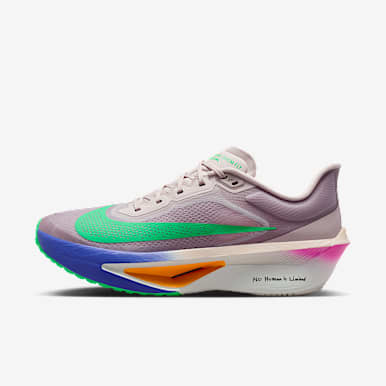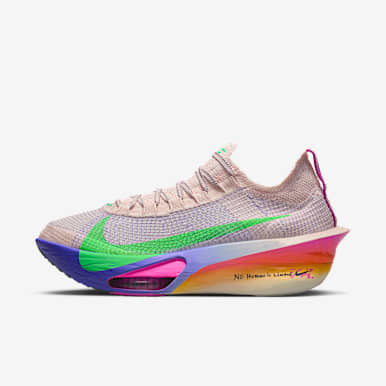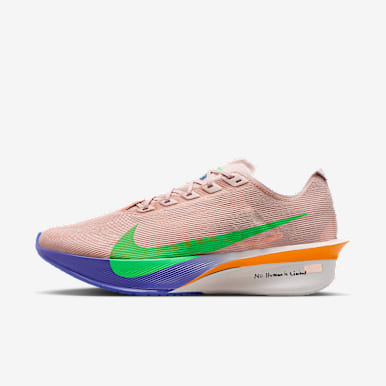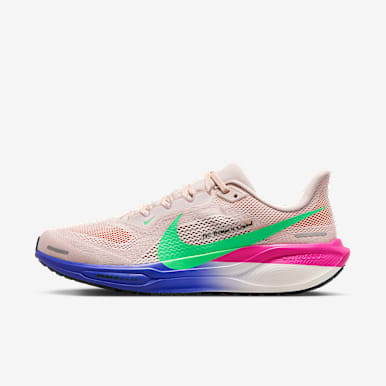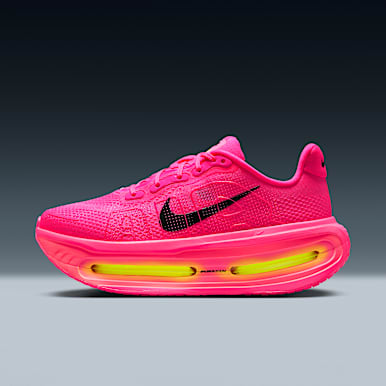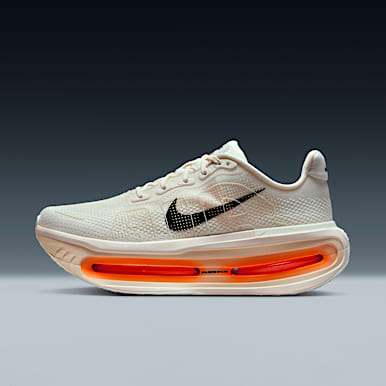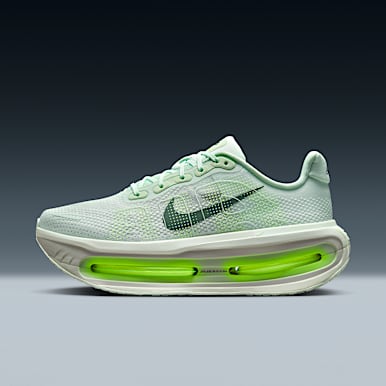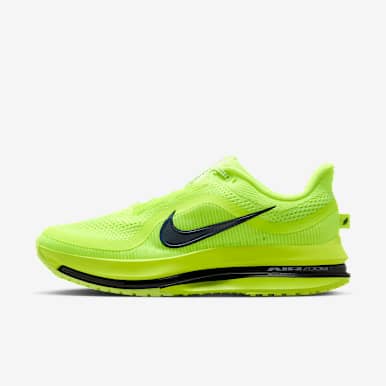4 Different Types of Running Shoes and Which Are Right for You
Buying Guide
Take the guesswork out of shopping with this handy running shoe guide.

Every great run starts at your feet. Or rather, with the shoes you put on your feet. The right pair makes the miles fly by. The wrong pair turns every step into a marathon.
To make sure you're set up for success, it's key to find the best running shoes for you. Trouble is, there are so many types of running shoes available, how do you know where to look? To top it off, manufacturers throw in terms such as heel drop, stability and supination, and words like outsole, forefoot and midfoot get added into the mix—it's no wonder runners get confused.
Fear not. Here's a rundown on the most common types of running shoes on the market. Plus, get helpful pointers for finding your perfect pair.
4 Types of Running Shoes, From Most Supportive to Least
There are many types of running shoes. 'Most can be considered along a spectrum of support, from minimalist to neutral, stability and, finally, motion control', says Jason Fitzgerald, a USATF-certified running coach and owner of Strength Running.
- Motion Control: At the top of the stability scale are motion control running shoes. According to Fitzgerald, motion control running shoes have all the bells and whistles: a firm chunk of foam in the inner midsole (known as a medial post), maximum arch support and a high heel drop (the difference in cushioning between the heel and toe of the shoe). These features aim to tame severe overpronation. Overpronation happens when your foot rolls inwards as you run.
- Stability: Next on the list are stability running shoes. These are for runners with less severe overpronation. Stability shoes dial back the support a bit by removing some of the cushioning, lowering the heel drop and slimming the medial post.
- Neutral: Neutral running shoes are for runners who don't overpronate. Pairs are typically lighter, feature a lower heel drop and provide most of the cushioning in the heel, Fitzgerald says.
- Minimalist: Like the name suggests, minimalist running shoes come with few frills. They aim to mimic the sensation of running barefoot. To do that, many minimalist shoes strip away any extra cushioning, drop the heel so the sole is nearly or entirely flat, and open up the toe box so your toes can spread. Expect very little support from this type of shoe.
Other Running Shoe Categories
In addition to the four common types of running shoes, there are a few other categories of running shoes to keep on your radar.
Road running shoes: These are designed to absorb shock to help safeguard your joints when running on hard surfaces. Both road running shoes and everyday running shoes offer the support and cushioning that most runners need.
Trail running shoes: These are for runners who take long runs on varied terrain. Many offer traction in the heel and toe for better grip, and they are cushioned to work on smooth, rocky ground. Nike trail running shoes have been engineered to withstand the muddiest of trails and most inclement weather.
Racing flats: This class of performance running shoe is designed for maximum speed. Nike racing shoes are super-light, with little to no heel drop.
Running spikes: Like racing flats, running spikes are built for quick performances. However, track running shoes feature sharp metal or ceramic spikes screwed into the sole. The spikes offer the traction you need to race on a track, or dirt- and grass-heavy routes.
'Only experience and a lot of trial and error will help runners understand their preferences and the type of shoe they prefer'.
Jason Fitzgerald USATF-certified running coach and owner of Strength Running
How to Find Your Perfect Pair
1.Identify your pronation type
Pronation refers to the way your foot rolls inwards when it strikes the ground. And pronation affects your running. A slight roll is normal, but many runners overdo it in one direction. These are categorised under two main pronation types: overpronation and underpronation. Your arch type or foot type can make a difference. People with low arches tend towards excessive pronation. Conversely, people with high arches tend towards excessive supination.
2.Overpronation vs. Underpronation
If you overpronate, your weight shifts too far inwards. If you underpronate (also known as supination), your weight shifts too far outwards.
The issue with overpronating and supinating is that neither allows your feet to absorb impact the way they should, which only adds stress and instability up and down the entire chain of your body.
Choosing shoes according to pronation type may help each foot land in an ideal position. This should help you distribute force coming through the ground, which may prevent pain and injury. Not to mention, the right shoe gives you a more comfortable run.
One easy way to tell if you supinate or overpronate is to take a pair of your well-worn shoes, flip them over and examine the wear pattern on the soles. If you overpronate, you'll find excessive wear on the inside edge of the soles. If that's the case, you may prefer stability shoes with a firmer midsole. Supination, on the other hand, will cause excessive wear on the outside edge. You may feel best in a neutral shoe, but test a few pairs and decide for yourself.
Some Nike shoes are best for overpronation, while other Nike shoes are best for supination. When in doubt, ask someone at your local Nike store for advice. They can offer shoe suggestions and even give you a gait analysis (a running test to assess your movement patterns) to narrow down your pronation type.3.Match the Shoe to Your Run
'Running shoes can certainly be used as training tools, so it's helpful to ask what type of run you're about to do', Fitzgerald says.
- Technical: If your runs carry you through rough terrain, trail running shoes may be your best bet.
- Speed: For fast intervals, opt for a lightweight, minimalist shoe. These won't weigh you down. Keep in mind that optimal road shoes will be different from optimal trail running shoes.
- Long distance: If you're going on long runs and will be on your feet for a longer period of time, you'll want to look for a shoe with more support, Fitzgerald says.
- Recovery: Fitzgerald suggests avoiding minimalist shoes and wearing a shoe with more support (such as a neutral or stability shoe) during easy recovery runs. This way, your feet and legs don't have to do as much work to keep you stable, keeping the focus on recovery.
Try the Nike Shoe Finder to help you find the right pair for you.
4.Consider comfort
At the end of the day, the right running shoe for you is the one you find most comfortable. Do you feel better in a high heel drop, or do you prefer a barefoot feel? Do flared heels (seen on many trail running shoes) mess with your stride? Are you a beginner or an expert at running? What kind of cushioning do you prefer?
'Only experience and a lot of trial and error will help runners understand their preferences and the type of shoe they prefer', Fitzgerald says. In other words, be ready to log miles in many different shoes to find your ideal pair.
3 Tips for a Secure Fit
- Cinch your laces so your sneakers stay secure while you run. But don't pull so tight that you feel pressure on the top of your foot.
- Check that your heel fits snugly in the back of the shoe. Not so tight that it constricts movement, but not so roomy that your heel rubs when you walk or run.
- Your foot should stay in place any time you take a step. The bottom of the shoe should bend with your foot, without any pinching or sliding.
Frequently Asked Questions About Running Shoes
How Do I Choose Running Shoes for a Marathon?
Longer distances call for a more supportive shoe. For training, look for a pair with more cushioning to absorb impact as the miles pile up. When race day comes around, you may want to lace up in a lighter, performance-focused shoe. Just be sure to log a few runs in your racing shoes before your race.
Which Running Shoes are Best for Beginners?
Beginners don't necessarily need a different shoe that someone who's racked up several marathons. In fact, the steps for finding a great pair are the same for all runners: Think about what types of runs you'll be doing, consider your pronation type and gravitate towards running shoes that feel good.
What's the Difference Between Training Shoes and Race Day Shoes?
Training shoes are typically slightly heavier with more cushion to absorb impact. This helps lessen the stress all those miles can have on your legs. The majority of your runs will use training shoes.
Racing shoes are built for performance and speed. They feature a lightweight design and responsive foam cushioning that propels you through every step. But don't save these for race day. Break them in with a few fast runs and check for a great fit and feel.
